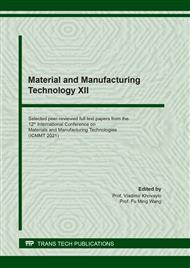[1]
R. Heijungs and J.B. Guinée: An Overview of the Life Cycle Assessment Method—Past, Present, and Future, In: Curran, M.A. (Ed.), Life Cycle Assessment Handbook: A Guide for Environmentally Sustainable Products p.15–42, Beverly: Scrivener Publishing, (2012).
DOI: 10.1002/9781118528372.ch2
Google Scholar
[2]
International Standard Organisation: ISO 14040:2006, Environmental management – Life cycle assessment–principles and framework, International Standard Organisation (eds), Geneva, Switzerland, (2006).
Google Scholar
[3]
International Standard Organisation: ISO 14044:2006, Environmental management - Life cycle assessment-requirements and guidelines, International Standard Organisation (eds), Geneva, Switzerland, (2006).
DOI: 10.3403/30290345
Google Scholar
[4]
D.R. Vieira, J.L. Calmon and F.Z. Coelho: Life cycle assessment (LCA) applied to the manufacturing of common and ecological concrete: A review, Construction and Building Materials 124 (2016) 656-666.
DOI: 10.1016/j.conbuildmat.2016.07.125
Google Scholar
[5]
Y. Zhang, W. Luo, J. Wang, various authors: A review of life cycle assessment of recycled aggregate concrete, Construction and Building Materials 209 (2019) 115-125.
DOI: 10.1016/j.conbuildmat.2019.03.078
Google Scholar
[6]
T.P. da Costa, P. Quinteiro, L.A.C. Tarelho, various authors: Environmental assessment of valorisation alternatives for woody biomass ash in construction materials, Resources, Conservation and Recycling 148 (2019) 67–79.
DOI: 10.1016/j.resconrec.2019.04.022
Google Scholar
[7]
A. Yazdanbakhsh, L.C. Bank, T. Baez, various authors: Comparative LCA of concrete with natural and recycled coarse aggregate in the New York City area, International Journal of Life Cycle Assessment 23 (2018), 1163-1173.
DOI: 10.1007/s11367-017-1360-5
Google Scholar
[8]
M.W. Tait and W.M. Cheung: A comparative cradle-to-gate life cycle assessment of three concrete mix designs, International Journal of Life Cycle Assessment 21 (2016) 847-860.
DOI: 10.1007/s11367-016-1045-5
Google Scholar
[9]
M.U. Hossain, C.S. Poon, I.M.C. Lo, various authors: Evaluation of environmental friendliness of concrete paving eco-blocks using LCA approach, International Journal of Life Cycle Assessment 21(2016) 70-84.
DOI: 10.1007/s11367-015-0988-2
Google Scholar
[10]
C. Knoeri, E. Sanyé-Mengual and H.J. Althaus: Comparative LCA of recycled and conventional concrete for structural applications, Int J Life Cycle Assess 18 (2013) 909-918.
DOI: 10.1007/s11367-012-0544-2
Google Scholar
[11]
PRé Consultants: SimaPro Database Manual - Methods Library, (2020).
Google Scholar
[12]
D. Kellenberger, H.J. Althaus, N. Jungbluth, various authors: Life Cycle Inventories of Building Products, Final report Ecoinvent data V2.0 Nº7, EMPA Dubendorf, Swiss Centre for Life Cycle Inventories, Dubendorf, CH, (2007).
Google Scholar
[13]
J. Guinée, M. Gorrée, R. Heijungs, various authors: Handbook on life cycle assessment, Operational guide to the ISO standards, Part III: Scientific background, Dordrecht: Kluwer Academic Publishers, (2002).
Google Scholar


